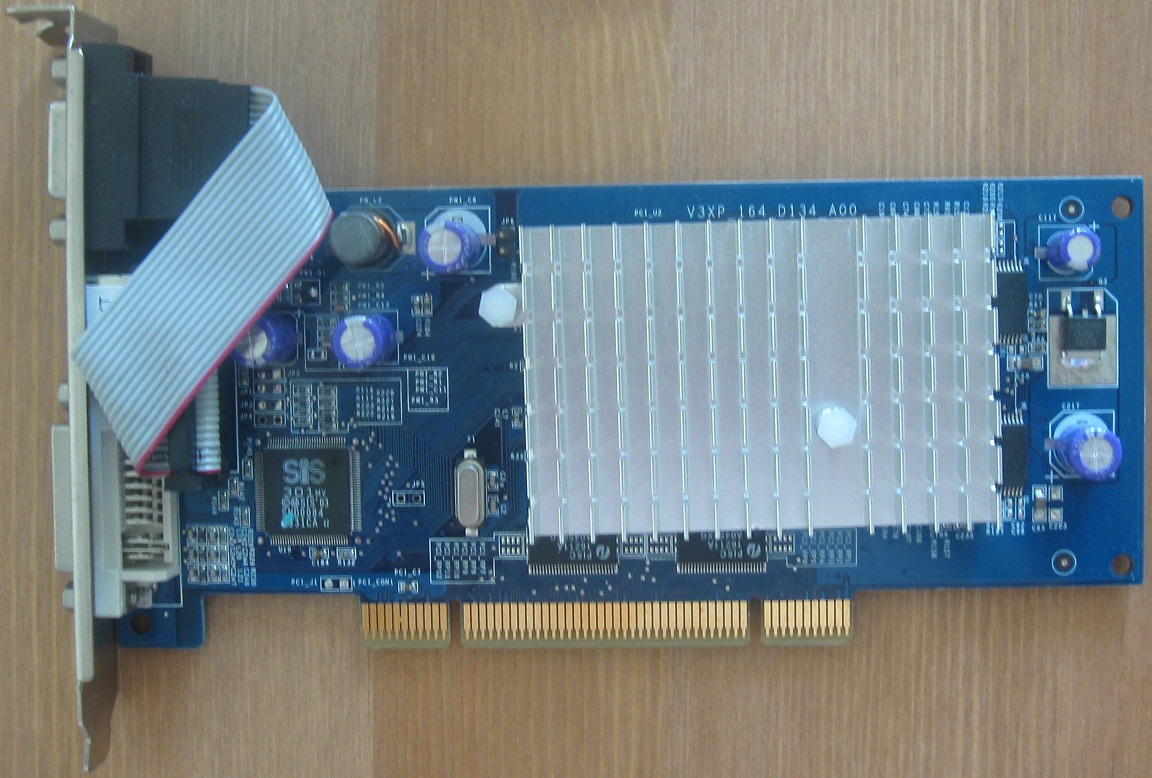Vintage 3D
January This month nothing retro, I was working on my database. Recently triangle setup rates became a bit interesting. I used these in one column with vertices transformation rates used for vertex shader era cards. Once unified shaders came, the numbers exploded and I stopped filling them. And now we finally have chips scaling triangle rates above one per clock (not necessarily rasterization). I wanted to put this in, so the values are finally divided into separate columns. As usual, the values are theoretical peak. In case of more options (like when some Geforce SKU has variable amount of GPCs) best case is used. For cards without setup engine, maximal triangle throughoutput will be used in that column. I certainly made mistakes when refilling them from top to bottom, but it will get fixed later.
2015 Happy new year. No promises on new content, time will tell.
October 2014 All articles were spell checked, things should be quite less embarrassing now. There are some new charts for my database, drawing single parameter for a time range of all the cards. I might draw some more interesting trends later.
August 2014 I really wanted to expand the functionality of this site over summer. After a dive into stinky php I found out mysql queries are failing whenever there are any quotes in them. I can't find a solution to this madness, but at least I finally know what the problem is. In another news one more SKU is added, the STG2000 variant of first Nvidia chip NV1. I managed to get one more or two more games running with them.
March 2014
Review of PowerVR Midas 3 is up.
February 2014
New data in database: die size, texture cache, and L2 (texture) cache. These parameteres are getting more attention recently, so I will try to collect them. More columns to come. Plan for next month: review of one really old chipset that can barely play anything. Sweet.
January 2014
This month I was looking back at Matrox cards, for two good reasons. Firstly new documentation that allowed me to drop few details on their architecture, secondly I got most of low resolution tests working. Last missing data is from 512x384, which I could get to work only with G100. There is even more to G100, I rejected the usual assumed clockrate of ~40 MHz. This came from supposed inheritance of divider by 3 used for older cards, and tools like Powerstrip are counting on it. Matrox register documentation claims 3 as only divider, but at the same time specifies reference clock of G100 as 71,5/143. That optional divider of 2 would explain how can my two G100 cards with very different system and memory clock perform as they do. I don't see any other reasonable explanation, so cards tested are now considered to have a lot more rational chip clocks of 62,5 or 66 MHz.
December 2013
Never enough time. But this month I finally reviewed card with Permedia chipset, and it was quite a battle with driver, no wonder others gave up on her. That was another missing piece in the puzzle, that is now almost complete. Almost, so good luck in 2014.
November 2013
More delays, so hopefully Christmas will provide me with enough time. RIVA 128ZX data are in and hopefully it is not last addition. Textures per TMU column was removed from the complete database view, it got too dull. Could do texture/shading ratio instead or other interesting trends of contemporary graphics.
October 2013
Still not finished, but let me throw some shameless self praise after thinking about this project. It ended up more resourceful than expected. Hopefully my work helps to correct some false opinions about old graphics cards that are still sometimes circulating on the internet. For example the "deceleration" of Virge, how Rage IIc is some cheaper Rage Pro, VT4 being 2D only, G100 having single TMU, triangle engine of Vérité doing triangle setup, the list goes on. I shed some light on texturing problems of 3D Image, d3d abilities of Imagine 128 II and Millennium. Discovered the differences within 6326 family, the two Laguna3D chips, several Mystique SKUs, performance differences between Virge/Trio3D generations, inefficiency of Voodoo Rush. I learned what infinite planes actually are, how many takes on blending operations there were, that some AGP implementations actually are helpful. I played games on the slowest of slow, on a DSP chip, on semi-professional cards, gazed in wonder at output of AT3D and admired one more time Voodoo Graphics. I feel tired and satisfied. It is quite exciting to relive the first, and most dynamic years, of consumer 3d acceleration. From the struggles of NV1 to the maturity of i740, there are so many different implementations, and the chips are still holding more secrets to be uncovered.
September 2013
Still compiling over 5000 results... Riva 128ZX will be added.
August 2013
July 2013
Another month when not much happened, I was merely updating the prolog. The conclusion is on it's way, because in addition to my job I will start university in September, making the deadline clear.
June 2013
My intention to provide some historical prolog to the content of the web turned out more difficult. Just for the sake of update I will publish it, even if it is far from good.
May 2013
My lazy month has passed. While there was nothing new on the main project, there is part of the web which is being updated continuously- the 3d accelerator database. It will soon reach size of 500 standard SKUs, sorted by real games performance (to my best knowledge). Needless to say this also took lot and lot of time. In June I would like to do some summary. There is not much more to do, until I get missing cards.
April 2013
Benchmark results should now be almost completely published and with navigation menu as requested. Turok is giving me trouble, many results, both from the screen or frapsed and both average and minimal, seem way remote from realistic performance. I am on a tight schedule in May so there is not much hope for big updates.
March 2013
February 2013
Well, this was really a lazy month. No new article, only revisions of old ones. I am continuing as usual, just slowly gathering last results. It took me a while, deciding on what I wanted to test. Inevitably, I was learning by doing, and fell into some redundant activities. Looking back I put every card for some additional test run around four times on average, because of revised methods, added tests, corrections and confirmation. Granted, I am getting tired of it, but the finish line is really near. Then will come publishing the results in a better way, programming some nice custom views, and moving onto something else.
January 2013
As planned the 3D Blaster PCI was tested and V1000 article was significantly rewritten. Next I expected to do 6326DVD review, with slow memory it would be the bottom offering of SiS. But when I saw 6326 C1 in action priorities have changed. It turned out there was yet another chip with broken perspective correction and there are other differences in 3d engine as well. This rougher than previously known entry of SiS into 3d world caused second major rewrite. C5 and DVD tests may come later, if I will be bothered with the gap.
December 2012
November 2012
October 2012
September 2012
I have begun the compilation of results into graphs, you can see them under results. It is a pure framerate for now, for all important image quality details stick with galleries and reviews. Finishing those should be my task this month. I am thinking about some IQ coefficient to express more complex results, despite the dangers of subjectivity. Still lots of things to do, but got to say I am satisfied with my work so far, I dare to say it far exceeds anything done before with first generations. Hopefully my own Diamond Edge 3400XL will arrive soon.
August 2012
Seeing how there is little hope now to get NV1 card for less $100 to start from the beginning I wrote article for last vintage3d related card in my possession- Riva128. I am going to continue looking around for missing cards and hope for help of similar minded people, but do not expect many interesting updates from now on. If time will allow me, I will compile measured data into graphs game by game. I may add one more test though. Out of necessity for cards without hardware texture mapping, but applicable to others as well, the "d3dtest" from earliest DirectX SDKs can help me determine at least a bit of performance for the most feature poor chips. As expected, the Imagine 128 II looks faster than the Millenium (60 MHz), though the Matrox chip can do important z-buffering. Fiddling with particular options did not change results of those two.
July 2012
I am done with ATI, but galleries will be completed later. My flash drive with pictures died... Anyway, I was precising articles and database as usual, but nothing worth writing about happened, had more of RL. My first Volari card arrived, it is humble V3XT PCI.
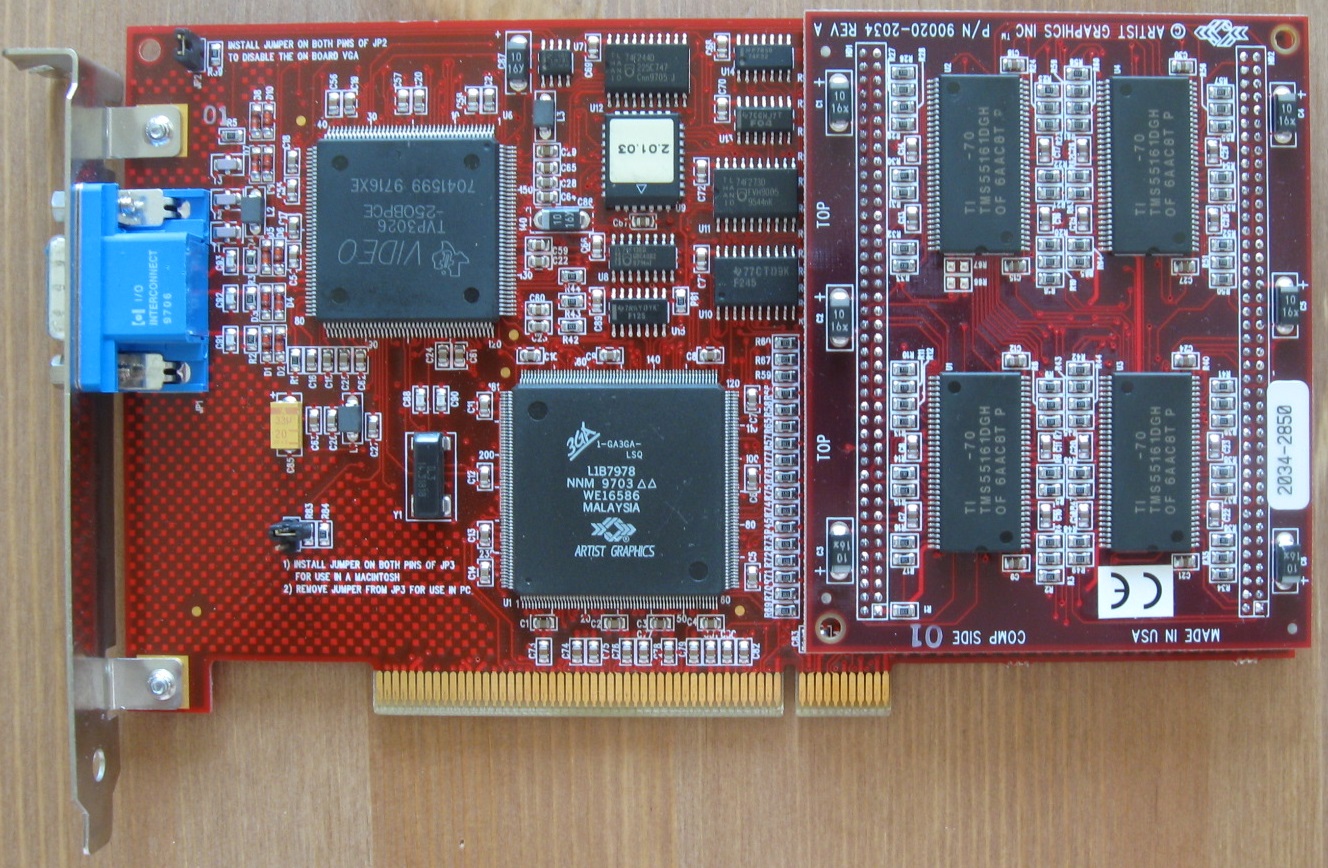 The conclusion is not here yet, but for a good reason. I acquired Mpact! 2 8MB and Laguna3D PCI 4MB cards. After the memory management issues of Mpact 2 4MB I expected better experience with more memory, and that indeed is the case. The Laguna3D PCI on the other hand was more surprising. Broken/missing features of CL-GD5464 can put it among early big failures of the industry. So there are two more SKUs, raising the total number tested to ~45. Way more then what I imagined when starting this. Oh, and here is sweet Netvision 2500i. 3GA chip by Artist was one of those early texture mappers that did not care about games. I want to examine it anyway.
The conclusion is not here yet, but for a good reason. I acquired Mpact! 2 8MB and Laguna3D PCI 4MB cards. After the memory management issues of Mpact 2 4MB I expected better experience with more memory, and that indeed is the case. The Laguna3D PCI on the other hand was more surprising. Broken/missing features of CL-GD5464 can put it among early big failures of the industry. So there are two more SKUs, raising the total number tested to ~45. Way more then what I imagined when starting this. Oh, and here is sweet Netvision 2500i. 3GA chip by Artist was one of those early texture mappers that did not care about games. I want to examine it anyway.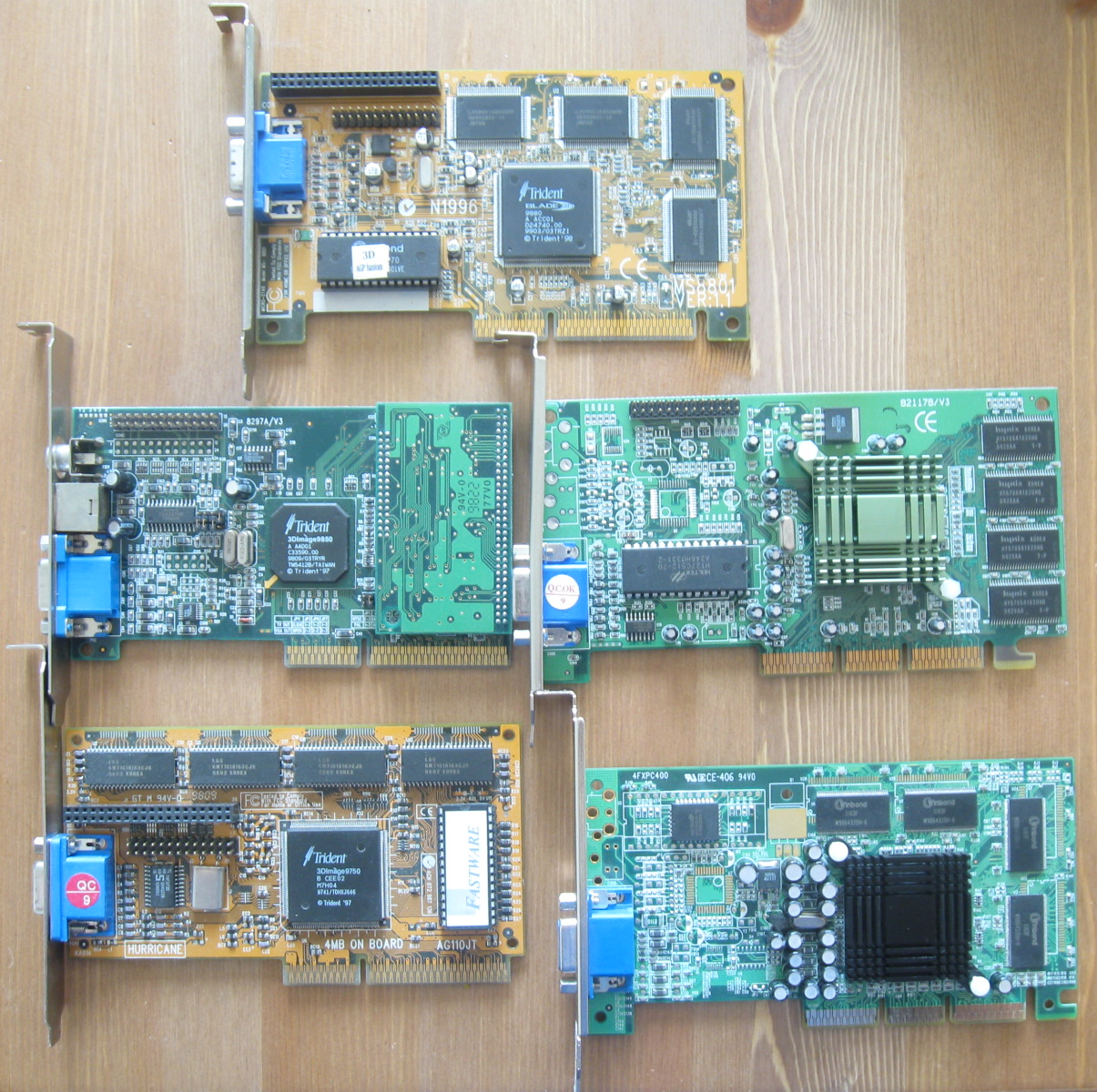 Not much have changed, but main news is benchmarking is complete. Final task is to publish results in proper fashion. After a long driver escapade, Mpact 2 managed to successfully sweep through every game on the list. This of course improves Chromatic's impression, as revised article should show. This month arrived last (hopefully) of the Trident's 3d desktop chip that was missing in my collection. If there will be a project following current one, let this be a hint what unknows I would turn to:
Not much have changed, but main news is benchmarking is complete. Final task is to publish results in proper fashion. After a long driver escapade, Mpact 2 managed to successfully sweep through every game on the list. This of course improves Chromatic's impression, as revised article should show. This month arrived last (hopefully) of the Trident's 3d desktop chip that was missing in my collection. If there will be a project following current one, let this be a hint what unknows I would turn to:
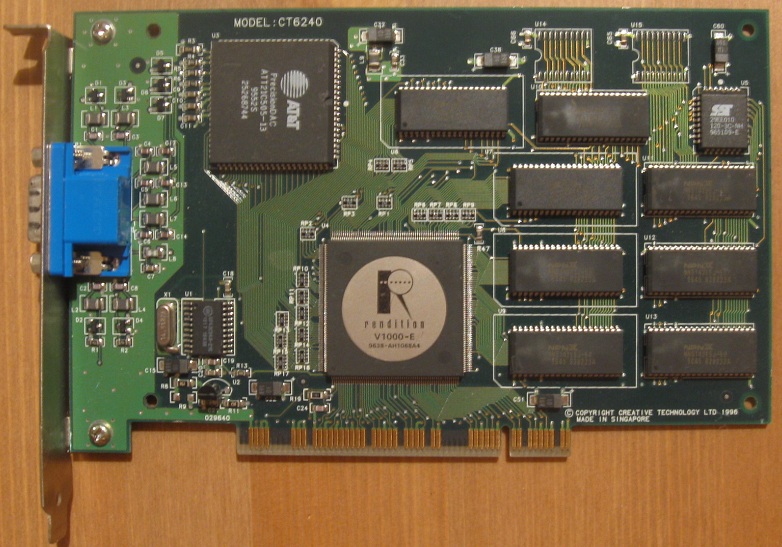
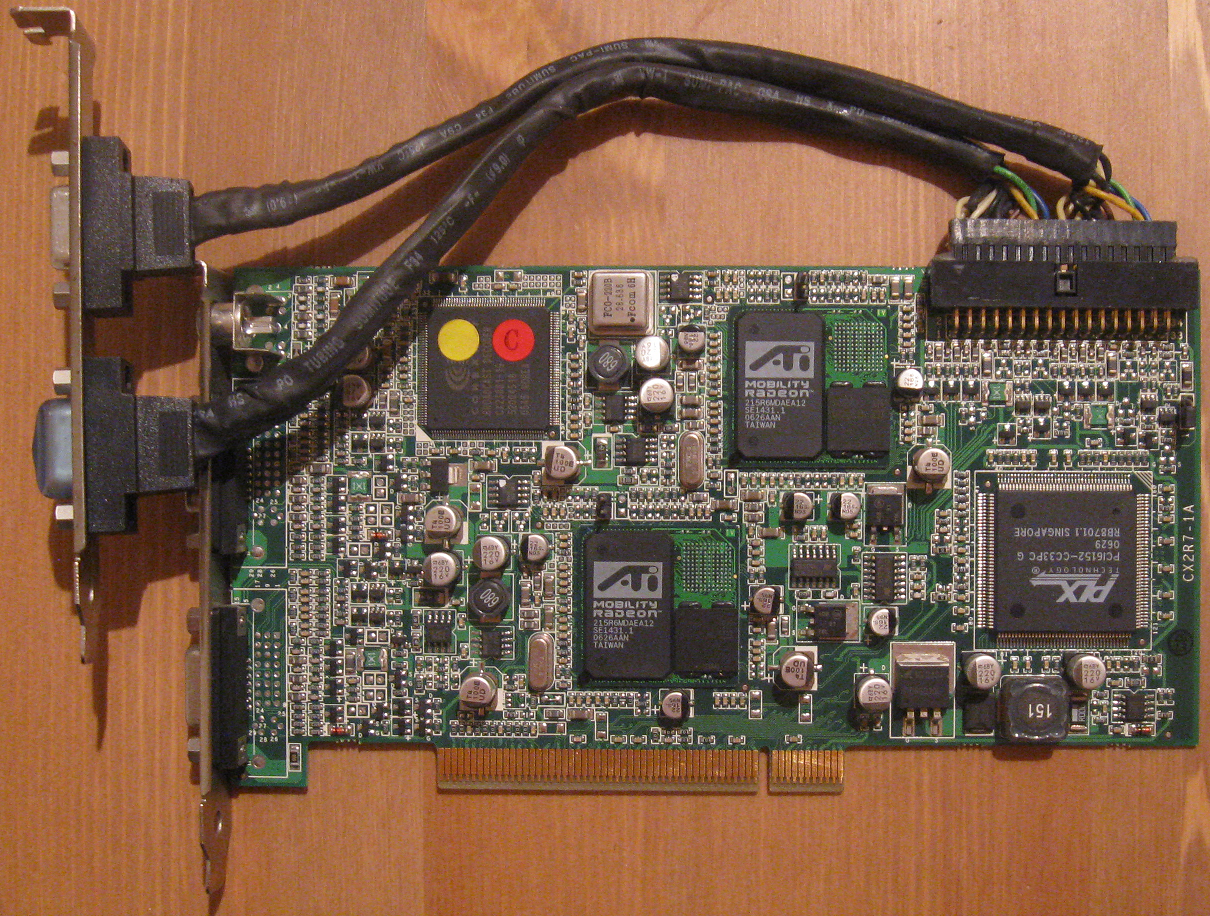 This month no new articles or purchases, time to save something for Christmas. I was correcting older texts though, some mistakes were quite big, fortunately rather language related. As you can see I am testing adds, wanted to have some help with hosting costs. I doubt they will make anything substantial, so probably will be removed soon.
Random interesting card from collection: one discrete board with two mobility Radeons for TV-out and four display outputs:
This month no new articles or purchases, time to save something for Christmas. I was correcting older texts though, some mistakes were quite big, fortunately rather language related. As you can see I am testing adds, wanted to have some help with hosting costs. I doubt they will make anything substantial, so probably will be removed soon.
Random interesting card from collection: one discrete board with two mobility Radeons for TV-out and four display outputs:
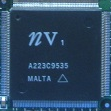 Not much progress with graphs, but there were other updates. First I added results for first Mystique in slowest variant. After playing with Trident Blade 3D I got a clue about AGP of 9850. With adjusted setup the card performed considerably faster, so I rebenched it from beginning. Finally, there is now review of the unlucky pioneer NV1.
Not much progress with graphs, but there were other updates. First I added results for first Mystique in slowest variant. After playing with Trident Blade 3D I got a clue about AGP of 9850. With adjusted setup the card performed considerably faster, so I rebenched it from beginning. Finally, there is now review of the unlucky pioneer NV1.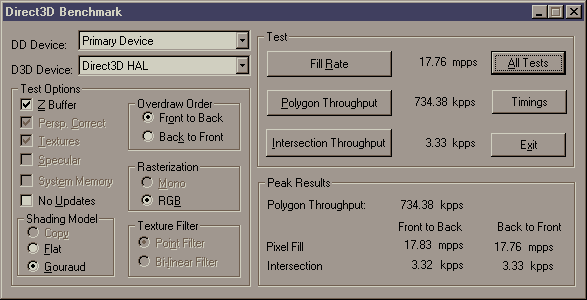 On the other hand Imagine II supports specular highlights. Click on the image to see its result.
Oh, and vintage3d.org made it into first birthday.
On the other hand Imagine II supports specular highlights. Click on the image to see its result.
Oh, and vintage3d.org made it into first birthday.
June 2012 I feel bad for not completing ATI reviews yet. However, there is no need to rush. The only other card in the queue is Riva 128 and I don't feel like starting with Nvidia before some NV1 comes my way. Maybe I could show here some purchases, since this is inevitably also about collecting. And I have a long way to go. In June I got this NEC TE5L, not sure if it was worthy for collectors, but multichips are always interesting.
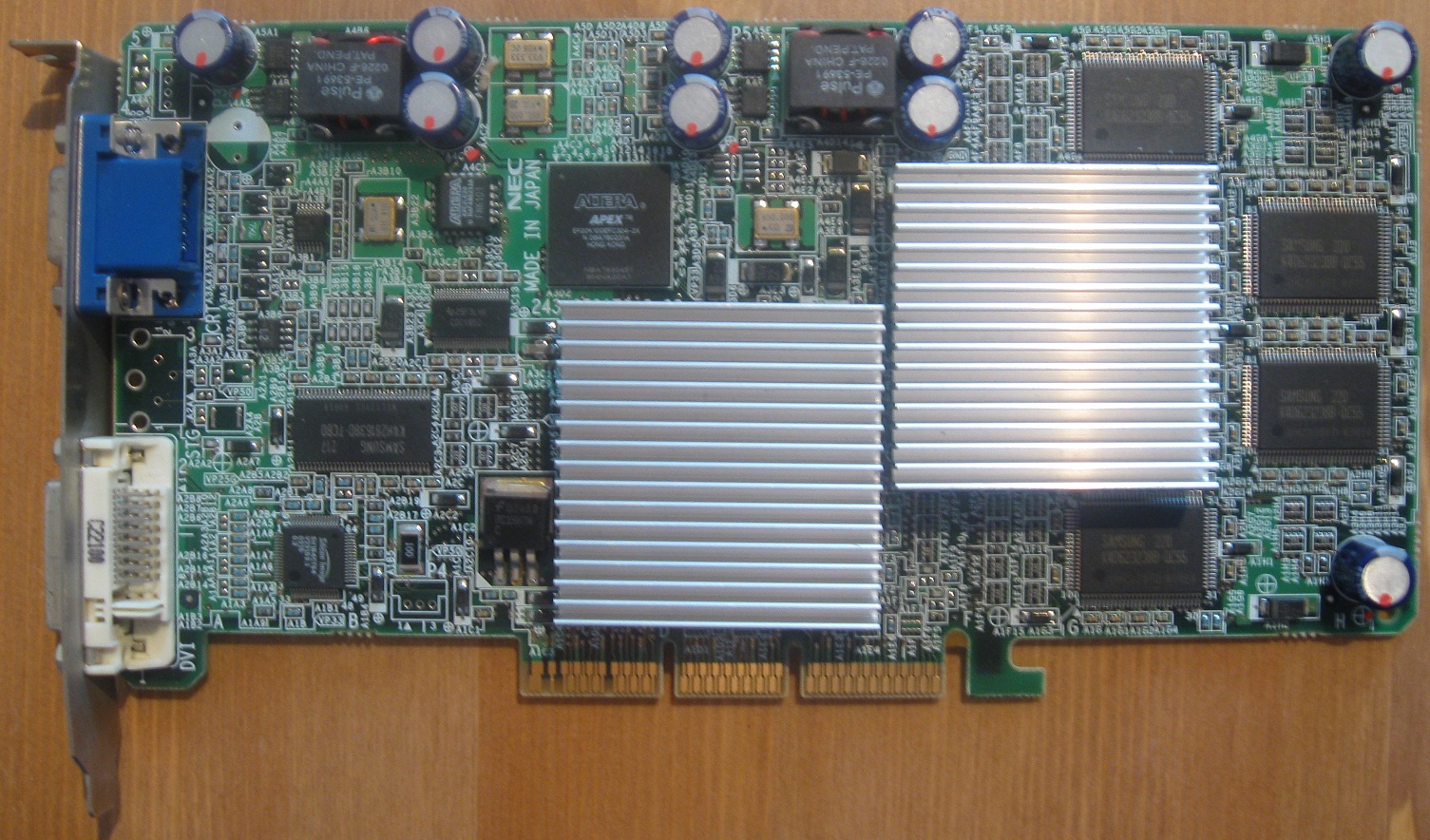
May 2012 The Virge series was really feeling incomplete without Trio3Ds, now it is done. I will finish Number Nine article very soon. Next month I can dive into ATI cards.
April 2012 Thought I should write something new here as well. This project is taking more time than I thought, but I can see the end coming at late summer- one year since the start of the web. As expected, some cards are almost impossible to get so things will not be as complete as I wanted. This is where you can come in. If you possess a rare vintage card fitting my scope I would much appreciate even a lend for one or two weeks. I know collectors don't want to give out their treasures :] That does not mean I will let this web/idea rot. I may be updating articles with new information as I am doing all the time and I can also later venture further to some newer underdogs, which were not really covered in press, SiS and Trident comes to my mind. The web side of things is depressing, writing things from scratch is not what I have time to spend on these days. I am getting over 1000 visits per month, which is what I expected. Most of it will be people still looking for drivers or other unrelated stuff. Not that I care, but some good template could make this web more pleasant experience and download section should do no harm either. I am getting linked more. Let me clarify my nick has nothing to do with Latino languages.
2011
Purpose of this website is to remember and find new information about the first generation of gaming 3D cards. What is first gen? Well, there are many definitions, common one would probably define three early generations of early 3d gaming chips: first geometry accelerators like Millennium or Imagine 128 II, then first texture mappers like Gaming Glint or Virge and finally "mature" architectures like Verite and Voodoo. I want to cover all of this range from very first accelerators (if possible) to anything released before Voodoo2. From there on 3d chipsets were having more and more comprehensive reviews and are therefore well known. I want to show barely tested chips in extensive collection of real games. The benchmark suite currently consists of around 40 games from 1996 to 1999 and 2-3 artificial benchmarks. Reviews are not done from user perspective. I am trying to examine and compare performance, which means no proprietary APIs. Cards are tested with latest or best available drivers and in a system saturating video accelerators with power unreachable at that time. In the future I might build a low end rig to examine performance in budget PC. The main purpose is to learn about chips, which were not reviewed extensively in ways we are used to now. In fact, information about gaming performance of most first generation cards is remembered almost only through word of mouth. I am not a professional hardware reviewer, neither graphics technology expert, but I will try to do my best to reveal real capabilities of vintage 3D cards.
My benchmarking practices are definitely not the best. I don't run the tests more times unless the results seem off. I simply don't have enough time. Also, most of the old boards lack the option to disable vsync despite trying various tweakers. Because of this I run all the tests with vsync, unless the application itself can disable it. This shouldn't be much of a problem with some high speed CRT, but I have only LCDs now. Therefore 75 Hz is used. Still the results have value, since vsync is almost always on by default and most of users don't change video settings. The performance corresponds to user experience, however speed differences between cards can be skewed.
